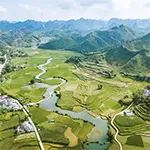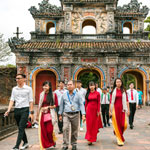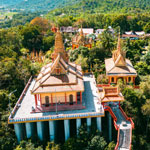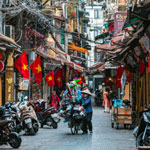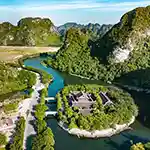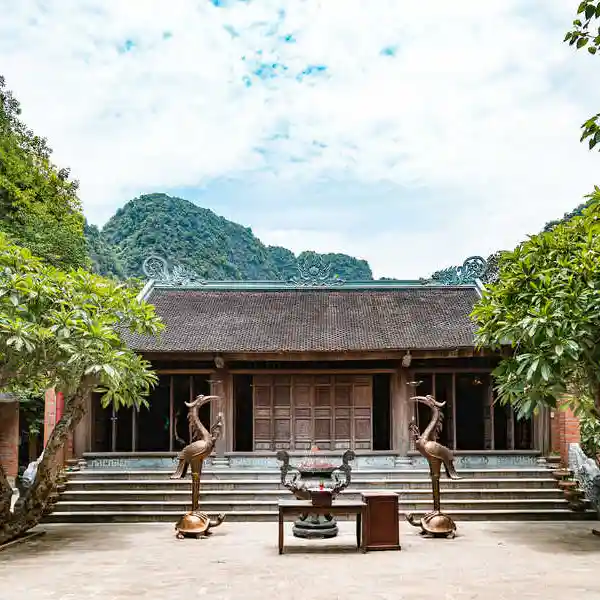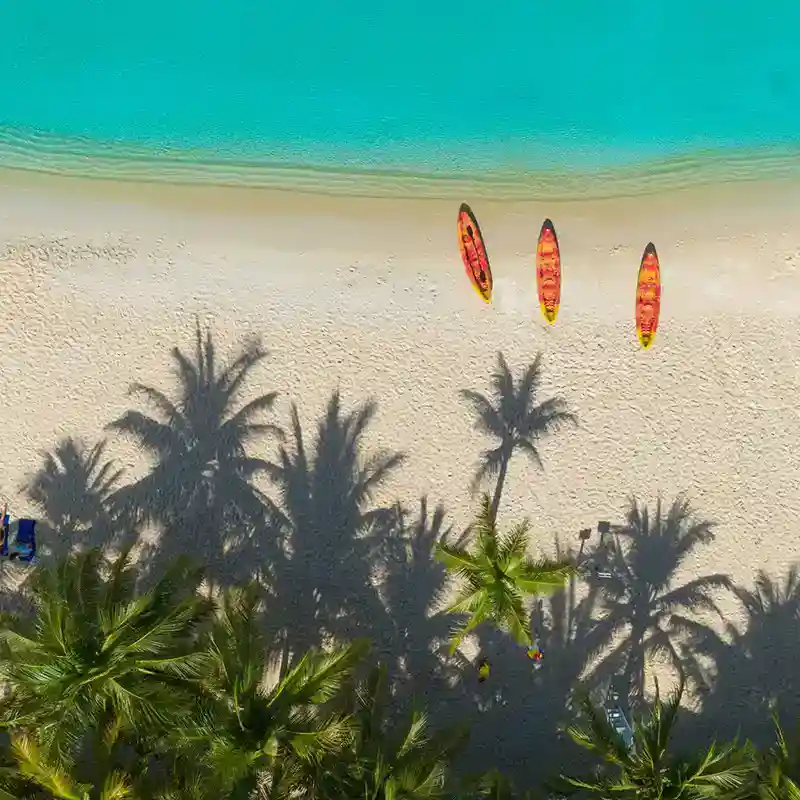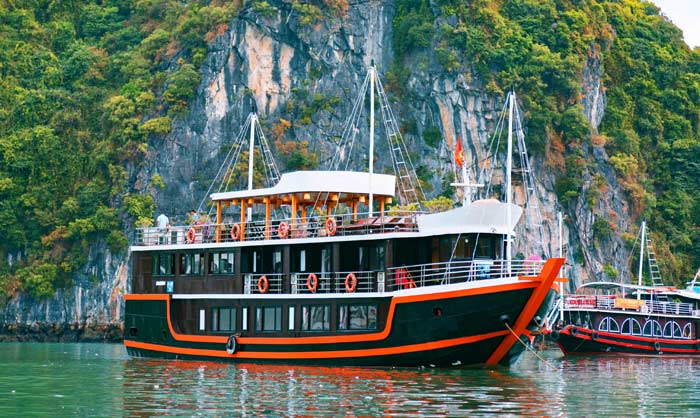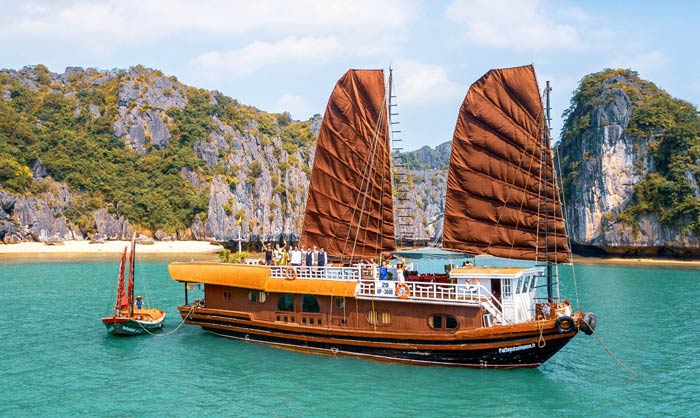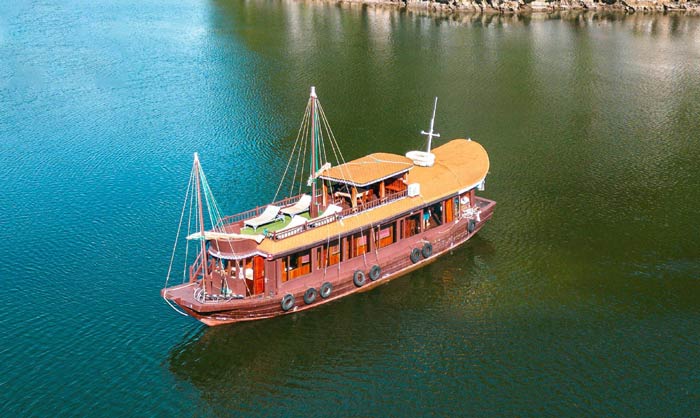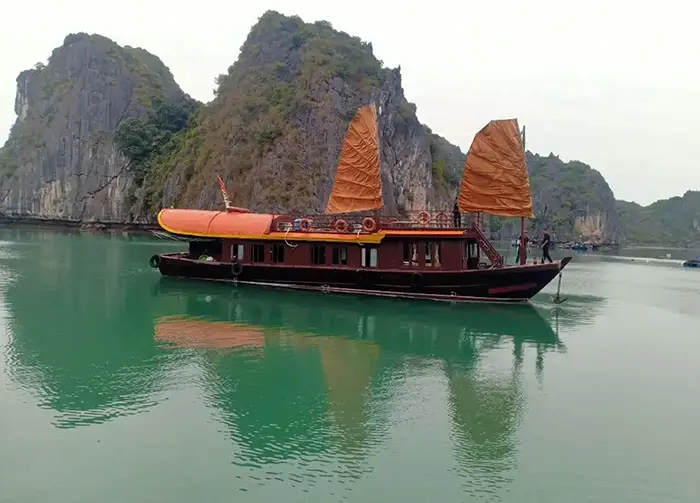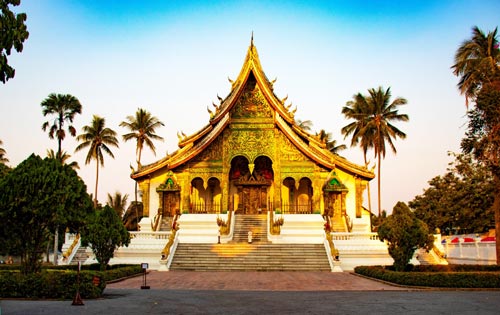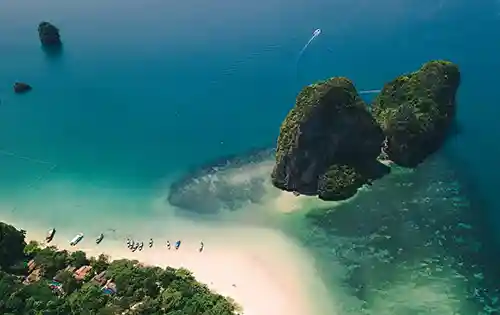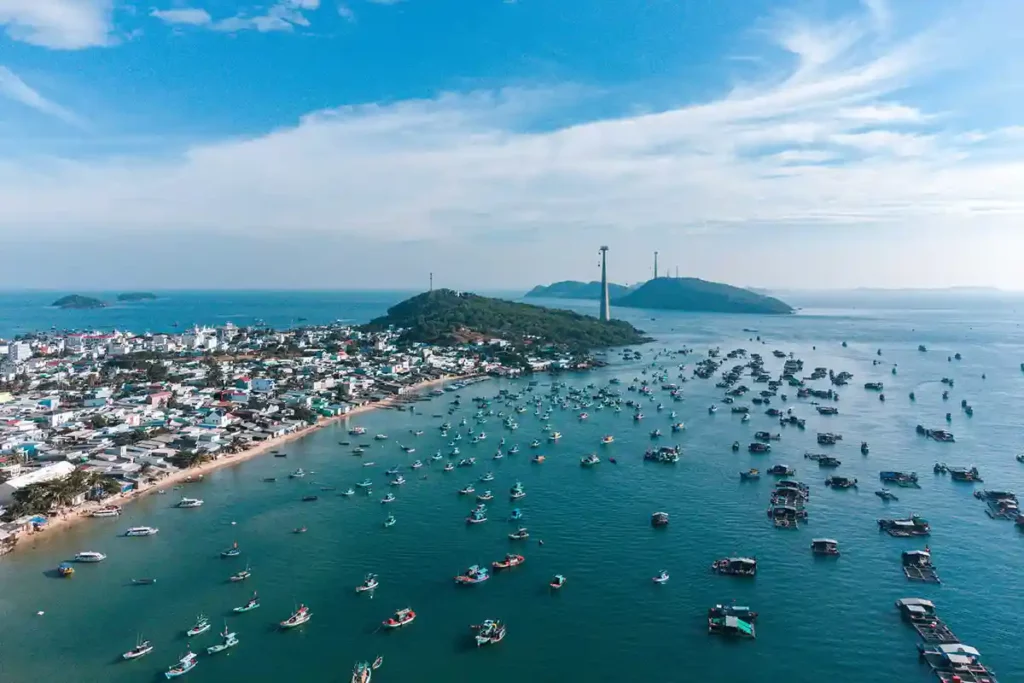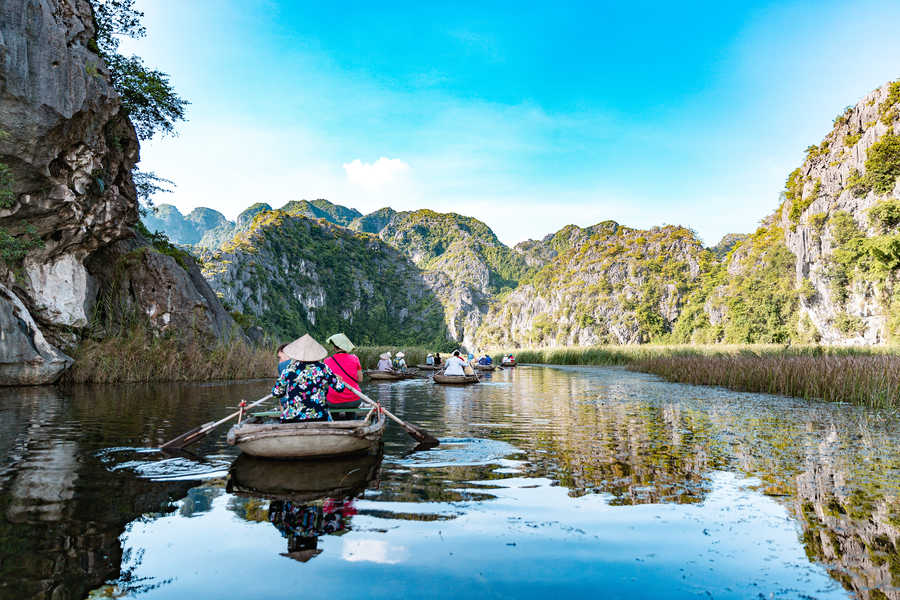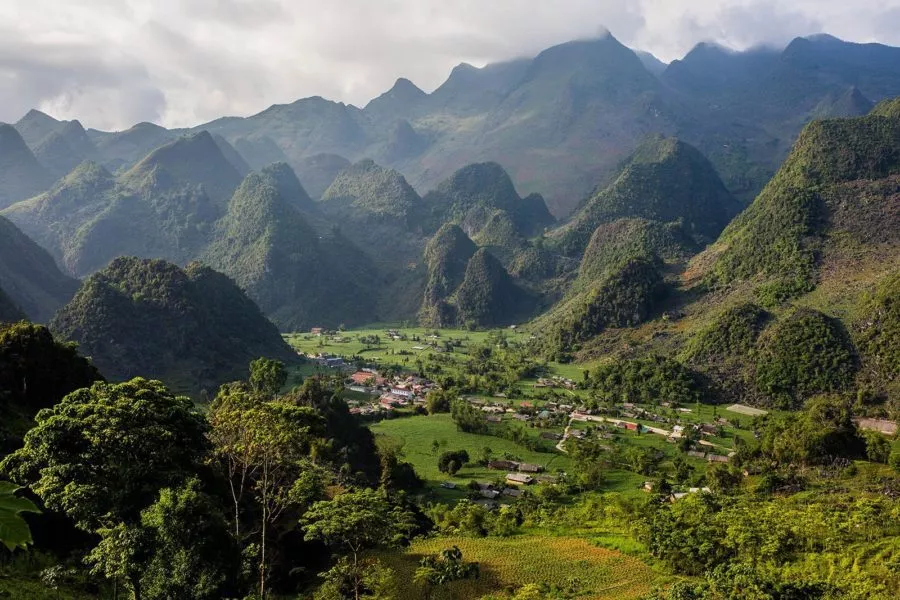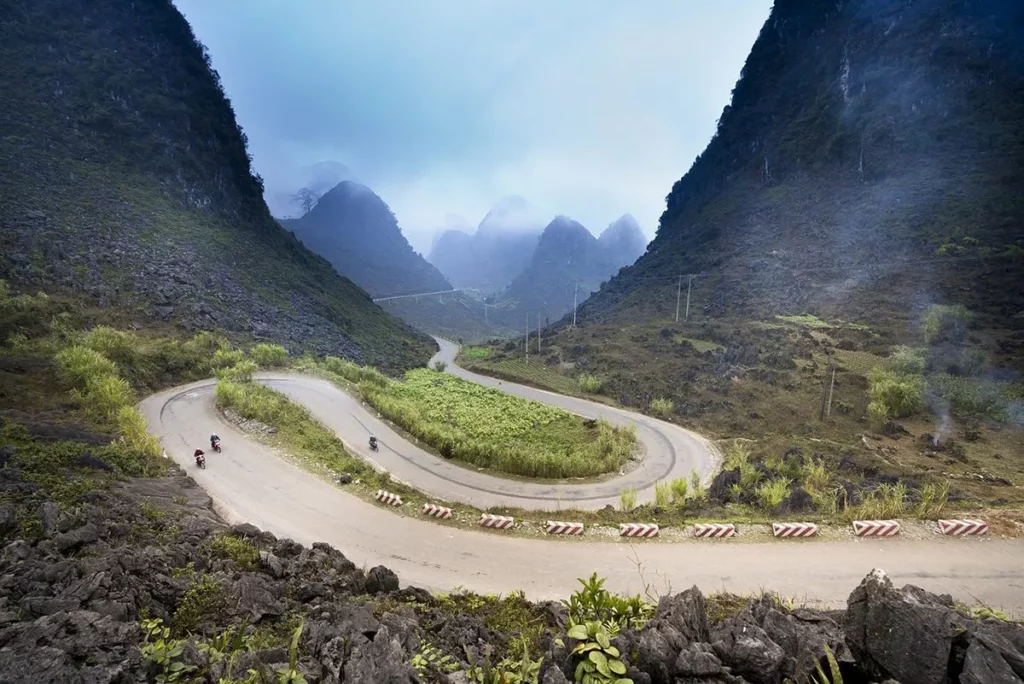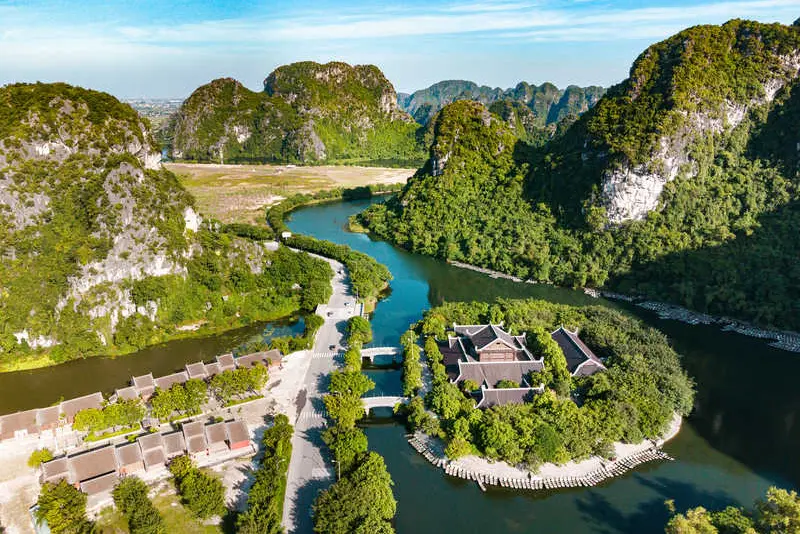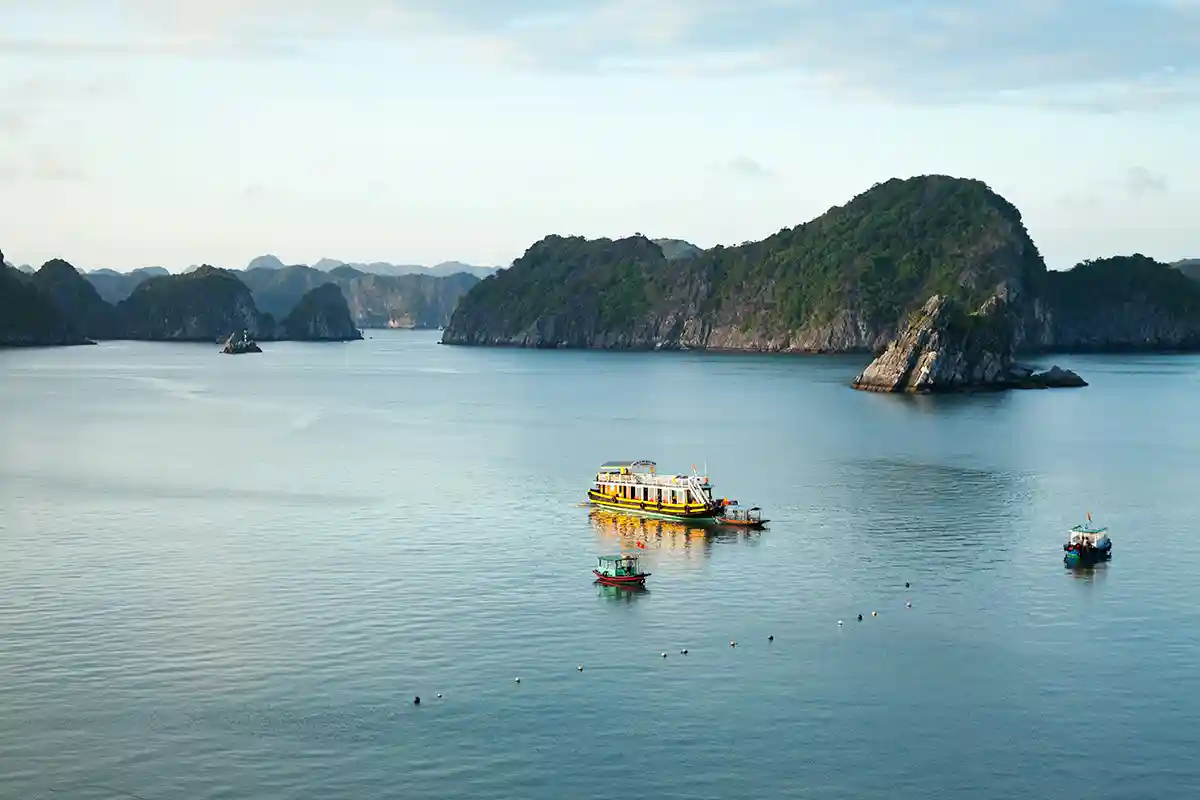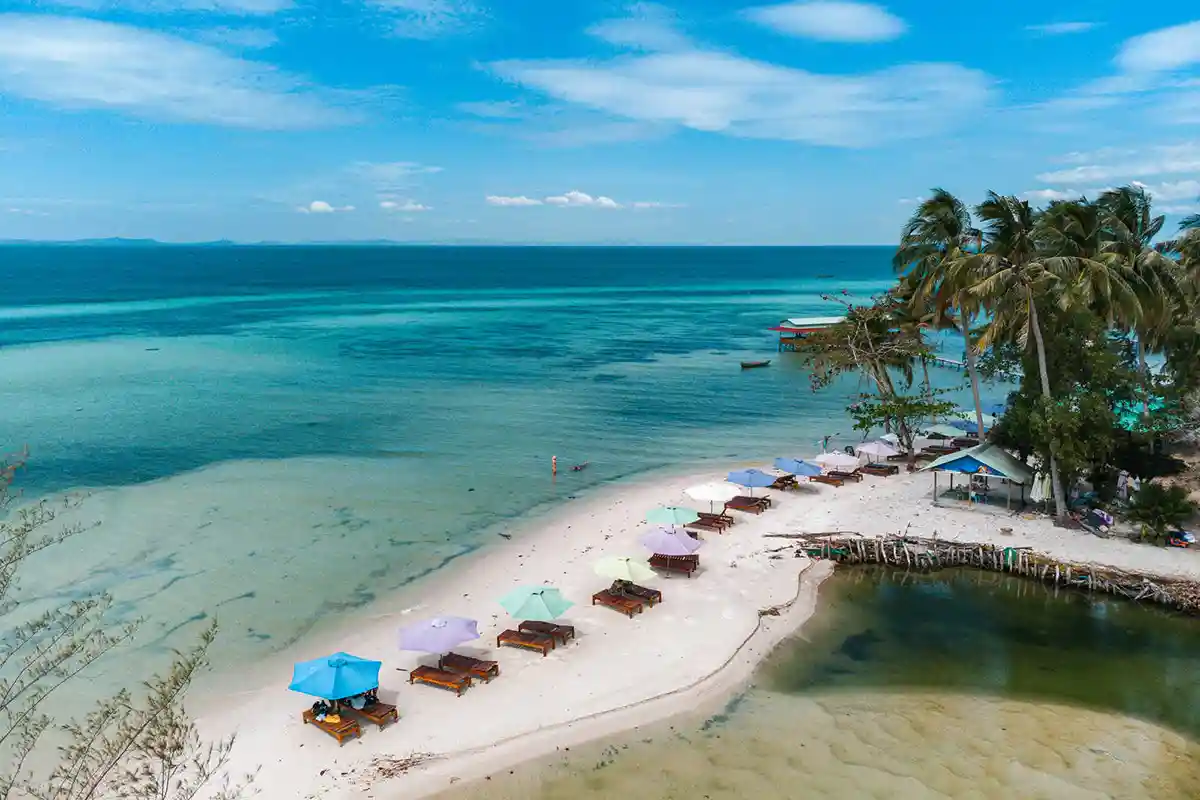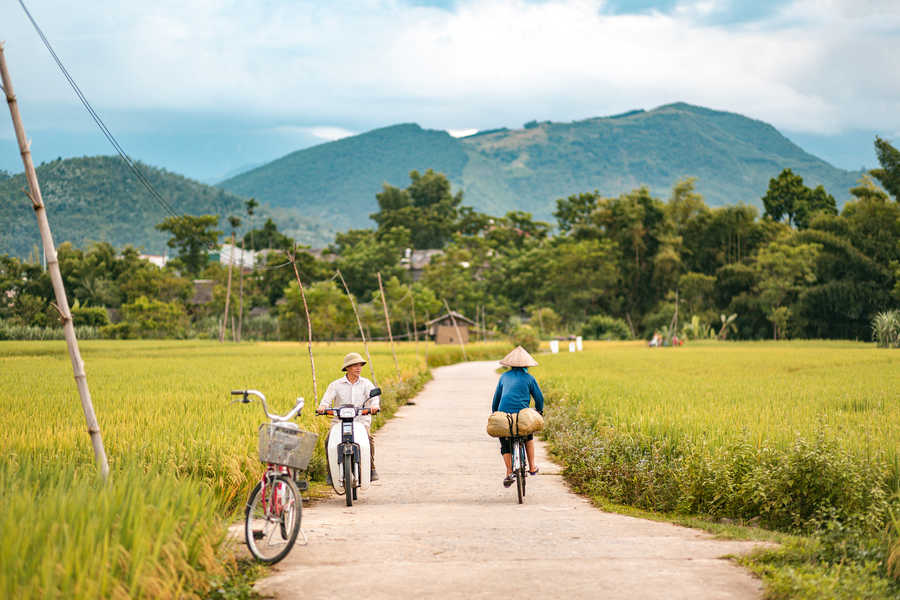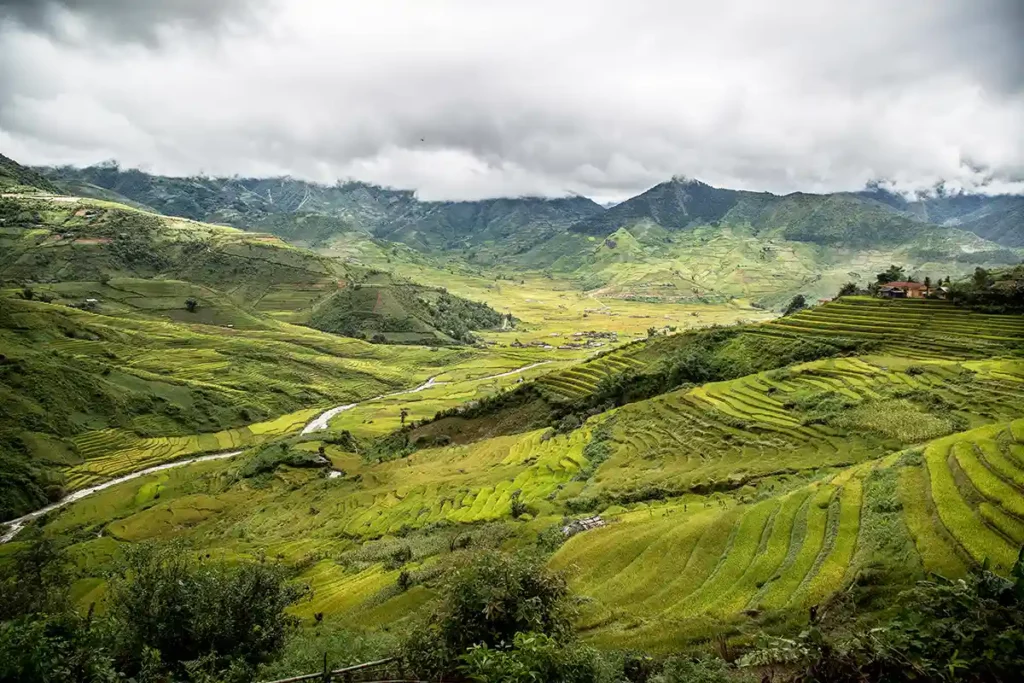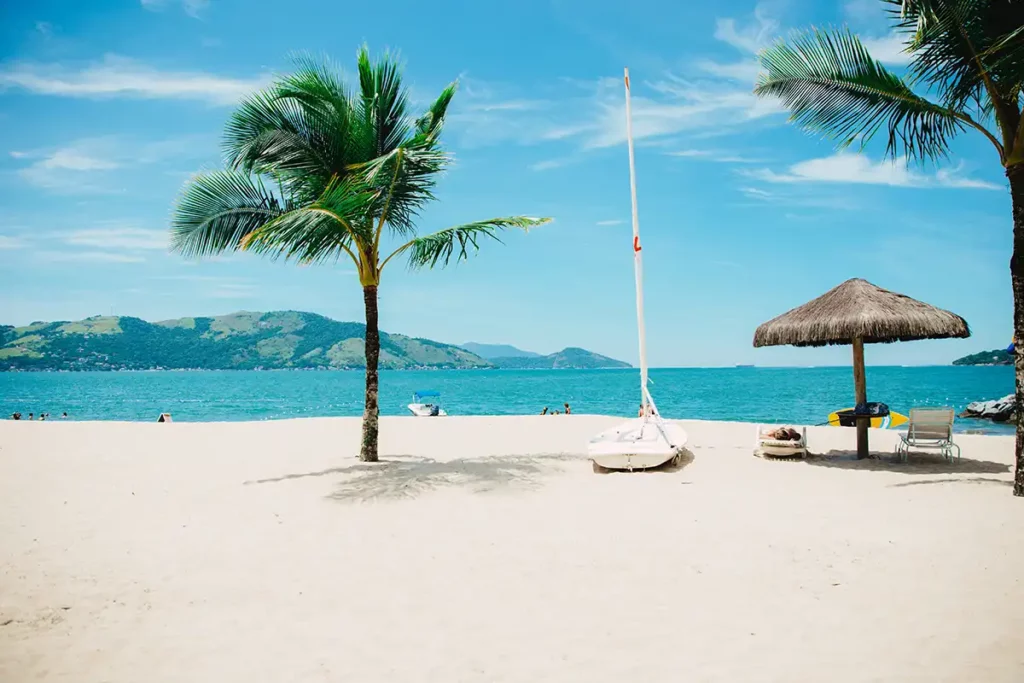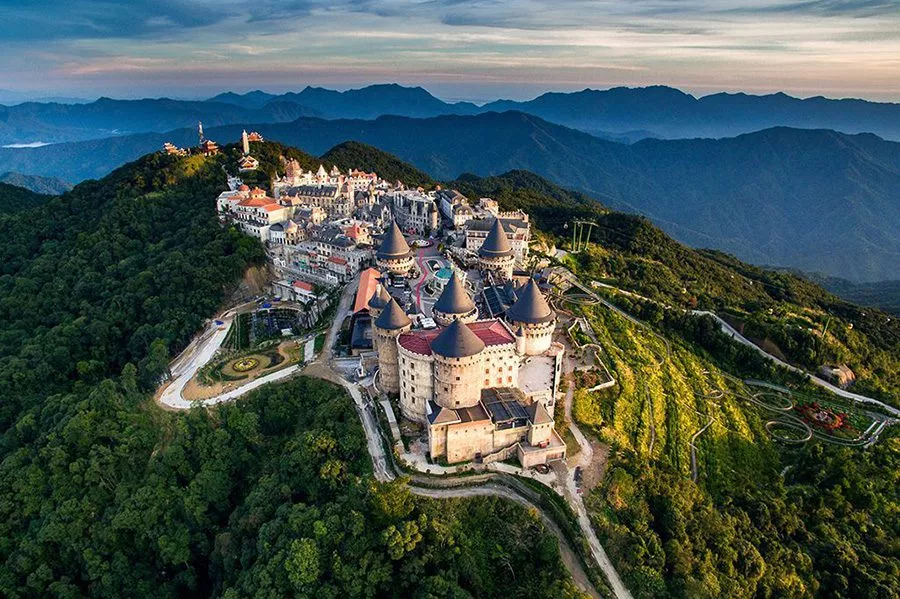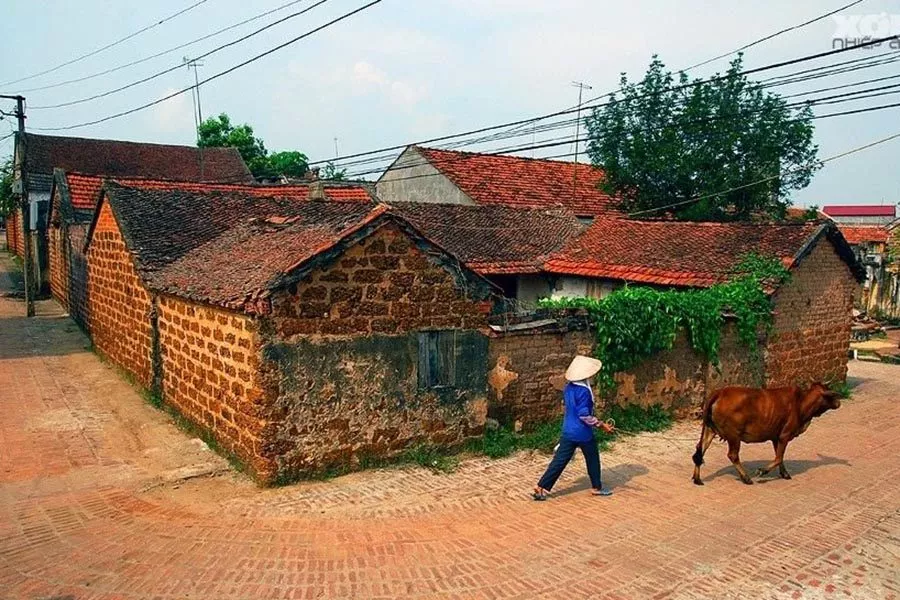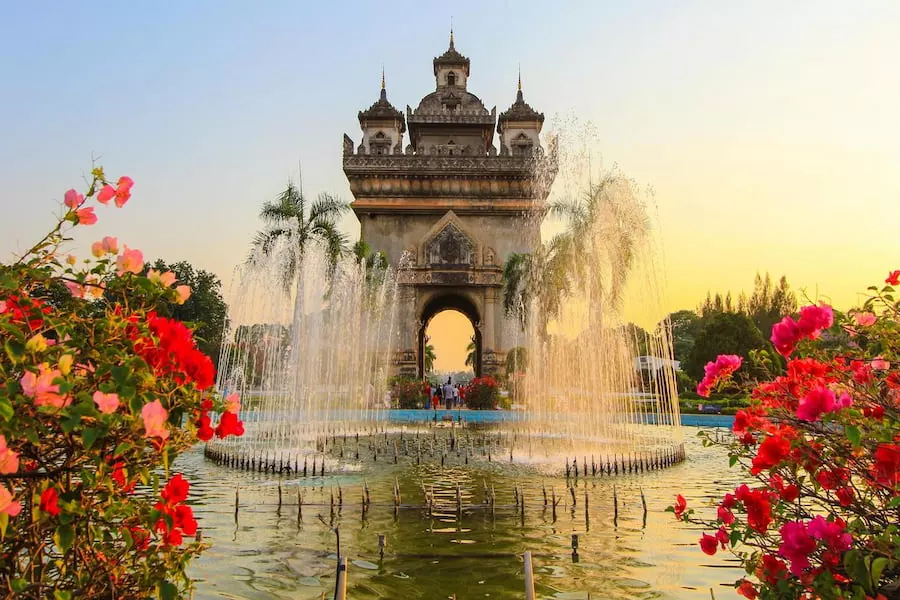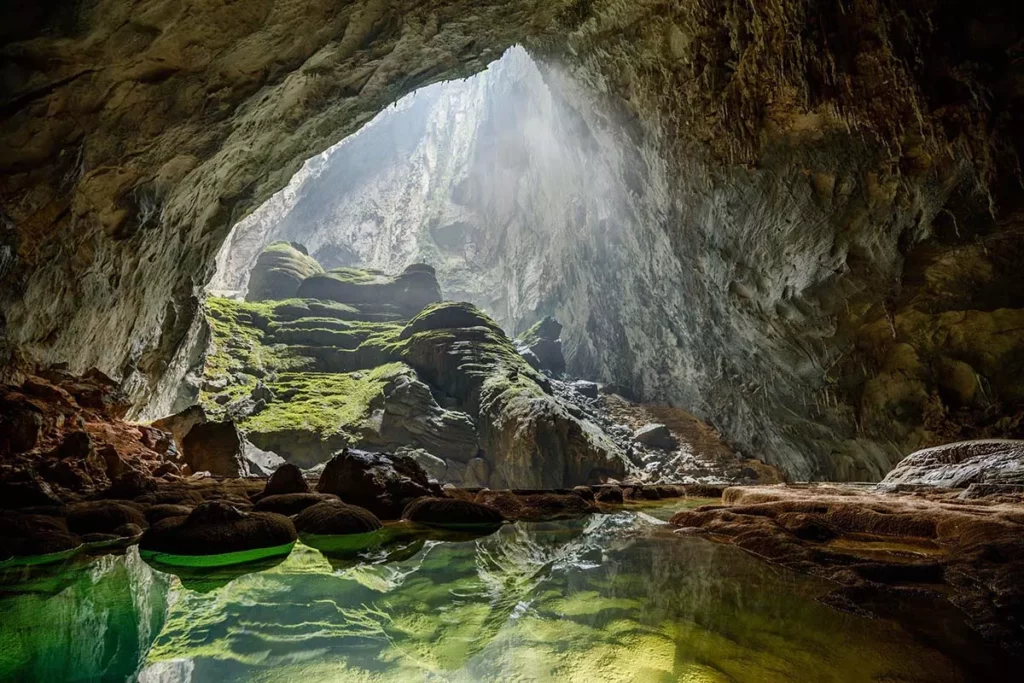Phu Quoc is a stunning island with crystal-clear waters, breathtaking sunsets, lush tropical landscapes, perfect sandy beaches, and welcoming locals.
It is the largest island in Vietnam, about the same size as Phuket in Thailand. The northern part of the island is relatively undeveloped, thanks to its status as a national park protected by UNESCO. The southern coast, on the other hand, is home to numerous luxury resorts, trendy bars, and cafes.
In this article, we’ll tell you everything you need to know before planning a beach getaway on Phu Quoc Island.
Contact us to create a tailor-made trip including Phu Quoc.
How long to stay on Phu Quoc Island?
Phu Quoc is the perfect destination to end your trip to Vietnam. We recommend at least two full days on the island to fully enjoy it, take part in a few activities we’ll mention below, and most importantly, relax.
When is the best season to visit Phu Quoc Island?
The year can be divided into three seasons:
High season – November to April: exceptionally pleasant weather with an average temperature of 30°C and clear skies.
Mid-season – May and June: the hottest months on the island. Expect occasional rainfall.
Low season – July to October: rainy and typhoon season, best to avoid.
How to get to Phu Quoc Island?
Phu Quoc is only a 45-minute flight from Saigon (Ho Chi Minh City), with regular daily direct flights. You can find one-way tickets for less than $50 with VietJet or Jetstar, Vietnam’s low-cost airlines. Keep in mind that they have strict baggage rules and often depart late. Flights from Hanoi take about two hours.
Fast ferries also operate from the mainland to Phu Quoc, departing from Ha Tien (1.5 hours) or Rach Gia (2.5 hours). Most travelers choose the Superdong ferry, which is punctual, air-conditioned, and comfortable.
Once there, a taxi from the airport to Long Beach costs around 150,000 VND. Jetstar also operates a shuttle to Duong Dong for 50,000 VND.
Where to stay on Phu Quoc Island?
You’ll have plenty of accommodation options on Phu Quoc. The island’s center, Duong Dong, is ideal if you want to stay close to cafes, bars, restaurants, and nightlife. If you prefer a quieter seaside experience, we recommend Ong Lang, Vung Bau, Ganh Dau, or An Thoi.
Recommended hotels:
# Budget: Island Life Hostel; 9 Station Hostel Phu Quoc; Dormstay Riverside; Seaside Homestay
# Mid-range: Lahana Resort; La Mer Resort; Little Garden Bungalow; Cottage Village; Nadine Resort
# Luxury: Camia Resort; Ancarine Beach Resort; Green Bay Resort; Dusit Princess Moonrise Beach Resort
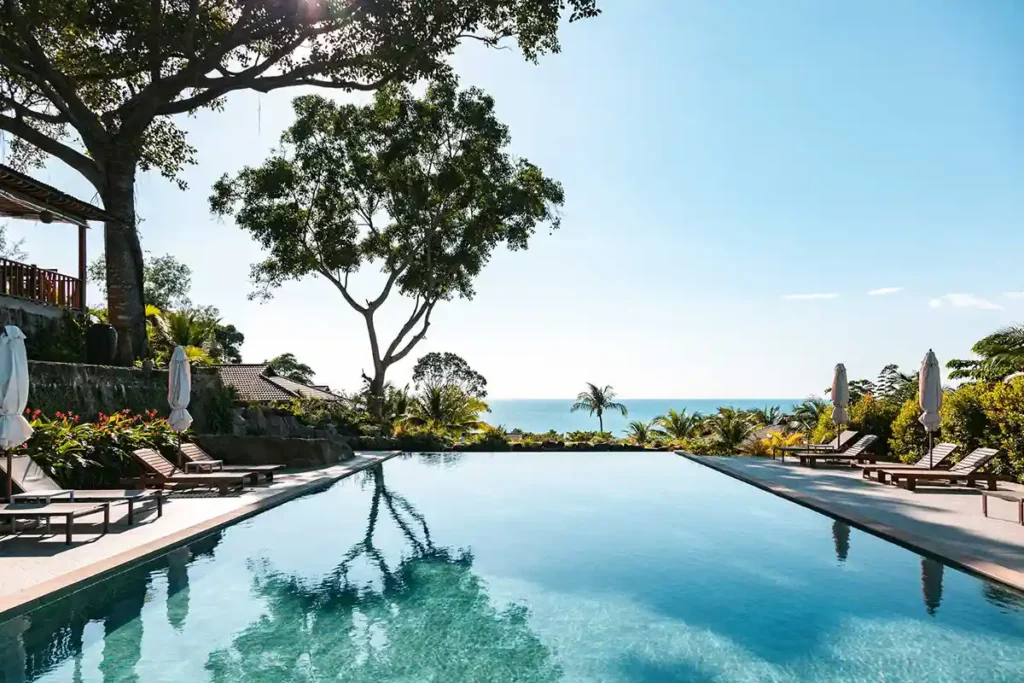
Camia Resort, Phu Quoc. Credit : Mathieu Arnaudet
Let’s move on to the activities to do on the island.
Top 10 things to do on Phu Quoc Island
As you might expect, most things to do on Phu Quoc revolve around the beach and the sea. It’s arguably the best beach destination in Vietnam, so… enjoy!
Enjoy the beaches
Let’s start with the most obvious one: relaxing on the beach. You’ll probably hear many different answers when you ask about the most beautiful beach in Phu Quoc. And that’s precisely because there are so many options — you really can’t go wrong!
Sao Beach is perhaps the island’s most picturesque, with white sand and crystal-clear water. There are plenty of parasols and sunbeds for rent to spend a relaxing afternoon. Since the beach faces east, you won’t see the sunset here — for that, head to the island’s west coast later in the day.
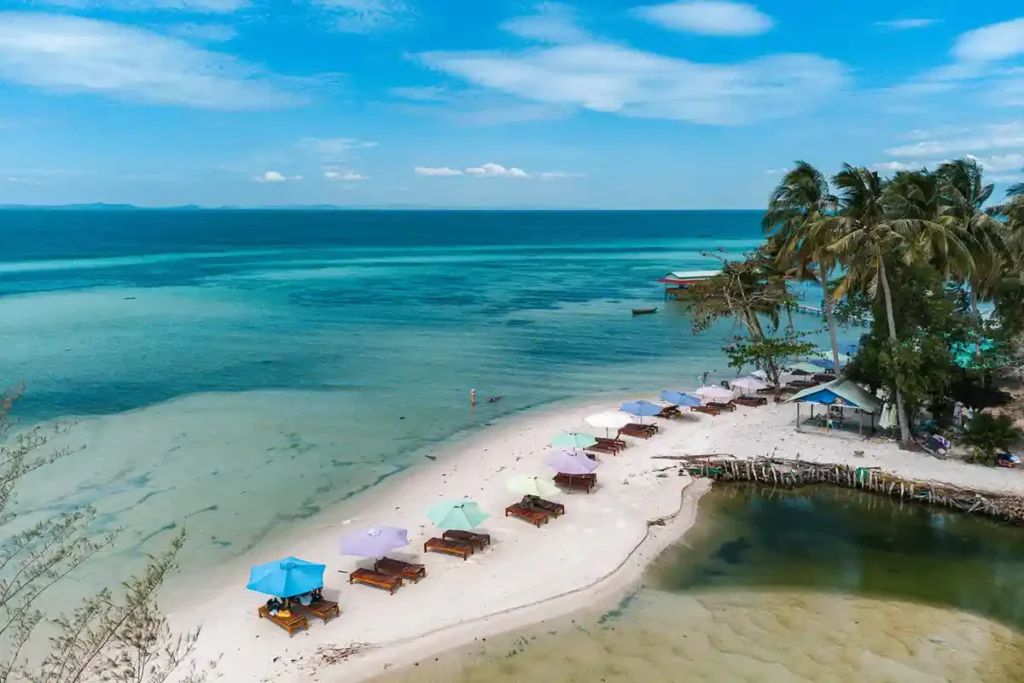
The parasols of Sao Beach, Phu Quoc. Credit: Mathieu Arnaudet
Long Beach (also known as Truong Beach or Bãi Trướng) is the most popular beach on the west coast of Phu Quoc Island. True to its name, the beach is incredibly long, stretching nearly 20 kilometers of golden sand. There are two sections to Long Beach — North Long Beach and South Long Beach.
North Long Beach stretches about 7 kilometers, from Trang An Phu Quoc Beach Resort at its northern end down to the Song Tranh Canal at the southern end. This part lies closer to Duong Dong Town (Dương Đông), the center of Phu Quoc. It is also more developed, with a variety of bars, restaurants, and hotels lining the shore.
South Long Beach extends for about 13 kilometers and is home to upscale resorts. It is separated from the northern end by the Sông Tranh estuary. Many resorts have their own private beaches, but it’s still possible to find access to public sections of the beach.
We loved watching the sunset a bit further north on the island, at Bai Ong Lang Beach. There are plenty of trees providing shade, and the beach is easily accessible to the public. Plus, the bar at Coco Palm Beach Resort often hosts live music in the evenings!
Sunset at Bai Ong Lang, Phu Quoc. Credit: Mathieu Arnaudet
Just around the corner from Bai Ong Lang Beach is Mango Bay. Technically, it’s a private beach accessible only through Mango Bay Resort. We walked along the shore without any issue, and it seemed that many swimmers weren’t actually hotel guests.
There are fewer beautiful beaches in the northern half of Phu Quoc. The coastline is rockier, with small sandy coves tucked here and there. These small beaches are more remote, and you’ll likely have them all to yourself. However, they aren’t as beautiful or well-maintained as those in the south — with the exception of Bai Dai Beach, located in front of the Vinpearl Resort. Unfortunately, it’s almost impossible to visit unless you’re staying at the hotel.
Visiting the small islands of An Thoi
Off the southern tip of the main island lie numerous small islets, each boasting beautiful beaches and crystal-clear waters. These can easily be explored by boat.
Several boat tours are available — you can opt for a speedboat to quickly hop between islands or a larger boat, which moves more slowly but offers a sundeck where you can enjoy a drink, have a barbecue, and even jump into the sea for a refreshing swim.
The most stunning of Phu Quoc’s islands form the An Thoi archipelago, located at the island’s southernmost point. This group includes 15 small islands, of which only five are inhabited, allowing the natural landscape to remain remarkably unspoiled and wild.
It’s important to remember that during the French colonial period, An Thoi was once a true hell on earth — a prison camp known as Coconut Tree Prison, where countless people were caged and tortured. Later, during the Vietnam War, the site was again used to detain political prisoners.
Today, however, An Thoi has become a peaceful paradise — an ideal spot for swimming, snorkeling, and scuba diving. Beneath the clear waters, divers may encounter bamboo sharks, angelfish, scorpionfish, and even the elusive dugong, a rare and gentle marine mammal.
Among the islands, Hon Dua — literally “Coconut Island” — lies closest to the town of An Thoi. Its name comes from the dense forest of coconut and mango trees that covers it. On the island’s western shore, divers can discover fragments of ancient porcelain scattered around the remains of a sunken ship — a fascinating glimpse into the region’s maritime past.
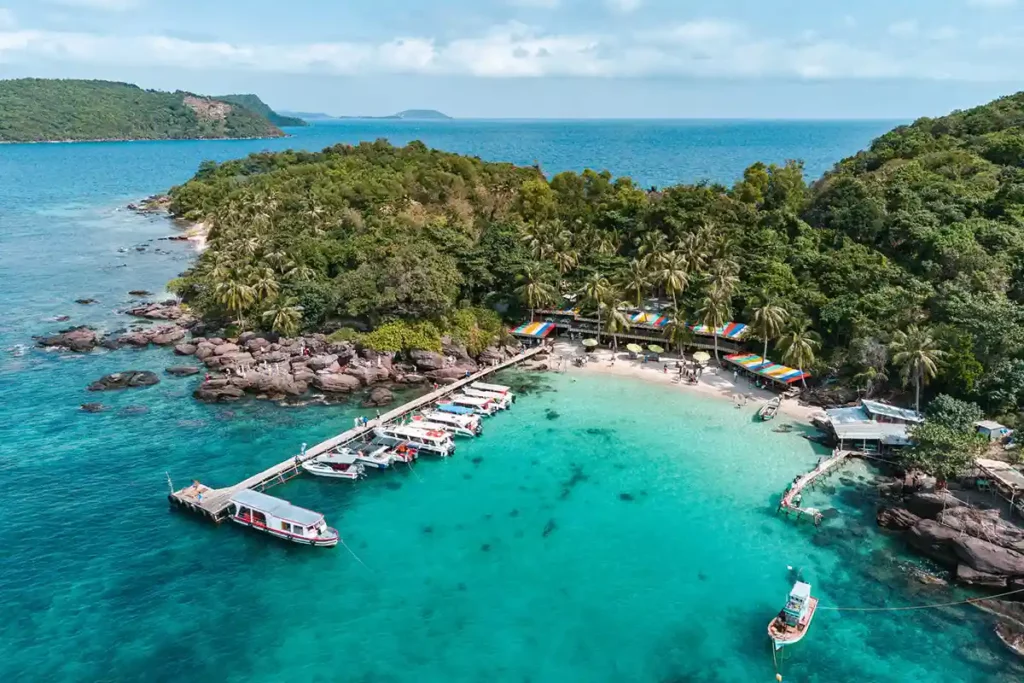
Hon Dua Island, Phu Quoc. Credit: Mathieu Arnaudet
Roi Island is the second closest island south of An Thoi Town. In the near future, this island is expected to resemble Vinpearl Resort off the coast of Nha Trang, welcoming luxury hotels and water sports arenas. These major development projects are about to take shape… So let’s go before developers claim this natural beauty as their own.
The third island from An Thoi Town is Hon Thom, or “Pineapple Island”. It is the largest island in the archipelago, with two hills rising 100 meters high at its northern and southern ends. The island has its own port and indigenous residents. It’s one of the busiest islands in the archipelago, constantly bustling with fishing boats. Hon Thom is also very famous for its beautiful tropical beaches and stunning coral reefs. Luxury resorts will soon emerge here as well, since SunGroup has literally bought the island…
Enjoy the cable car ride
The Phu Quoc cable car, owned by SunGroup, is a true technical marvel. It is none other than the world’s longest continuous three-cable car system. Located on the island’s southwest tip, your journey begins on Phu Quoc Island in An Thoi and ends on Hon Thom Island (also known as “Pineapple Island”). In between, you’ll enjoy a 20-minute ride offering incredible panoramic views of the surrounding islands.
During your cable car trip, you’ll have a breathtaking 360° view of the An Thoi archipelago, filled with small islands and vibrant turquoise waters. Just make sure to go on a clear day to get the best views from your seat!
Adults over 1.3 meters tall pay 500,000 VND per person, children between 1 and 1.3 meters pay 350,000 VND, and children under 1 meter travel for free.

View from the Phu Quoc cable car cabin. Credit: Mathieu Arnaudet
Visiting Ham Ninh Fishing Village
To get closer to the island’s cultural and economic practices, you can visit the fishing villages along the coast. There, you’ll see how boats are repaired on land, discover the fishermen’s houses, and spot the traditional basket boats used to paddle out to the larger fishing vessels anchored offshore. It’s an authentic experience and a refreshing change from the laid-back beach life.
We especially recommend visiting Ham Ninh, one of the oldest fishing villages in Vietnam. It’s located less than 20 km northeast of Duong Dong town center. There are many interesting places to explore around the fishing village, such as Bai Vong Port and several peaceful beaches. It was actually the French settlers who first decided to anchor their ships here and later established a fishing village. The Ham Ninh coastal area is quite shallow, revealing vast sandy stretches at low tide, while at high tide the water rises up to the edge of the forest. From Ham Ninh Beach, you can see Pirate Island, Nghe Islet, and Ong Hoi Cape in the distance.
Go Diving and Snorkeling
Snorkeling is, of course, one of the most popular activities on Phu Quoc Island thanks to its calm and pleasantly warm sea. You can book a full-day excursion dedicated to this activity, taking you to Finger Island, Dam Ngang Island, and May Rut Island. You’ll discover beautiful colorful corals and a rich, diverse marine life. There are plenty of diving options on Phu Quoc, suitable for both beginners and experienced divers.
What to pack for snorkeling?
# A waterproof bag for your dry items like clothes and your phone
# Towel, swimsuit, and a change of clothes;
# Reef-safe sunscreen or UV-protective clothing;
# Snacks or lunch for a midday break (and a bag for your trash)
# Enough water for the day
# A beach hat
# A waterproof camera for great underwater shots
# Some cash for emergencies — but not too much
When is the best time to go snorkeling in Phu Quoc?
The best time to snorkel in Phu Quoc is from November to April, during the dry season when the sea is calm and crystal clear. Overall, as we’ve seen, this is also the best period to visit the island and enjoy all its outdoor activities.
Buy Phu Quoc pearls
Phu Quoc pearls are of exceptional quality and have gained significant value over the years. If you’re looking for something luxurious and authentic to offer as a gift, they make an excellent choice.
Pearl farming has existed on the island for hundreds of years, and Phu Quoc’s calm waters and clean environment provide the ideal conditions for oysters to produce beautiful pearls. Many pearl farms welcome visitors to discover the different stages of cultivation and jewelry crafting. While pearls can be found in many souvenir shops, only about 20% of the pearls sold on the island are genuine high-quality pieces. For this reason, it’s best to buy directly from the farms, where you can also learn about their production.
Prices vary depending on color, quality, and shape. The rare black pearl can cost over 1,000 USD, while standard pearls are around 40 USD, and simple ivory pearls can be bought for just a few dollars.
Visit local plantations
Beyond its pristine beaches, Phu Quoc is also famous for its pepper and its legendary fish sauce, both key ingredients in Vietnamese cuisine. Scattered across the island, pepper plantations and fish sauce factories can easily be visited to observe the traditional production process — and of course, to buy some authentic local products to take home.
Phu Quoc pepper
Phu Quoc pepper is prized throughout Vietnam for its spicy aroma and rich flavor. Grown without any chemical fertilizers, the island produces black, red, and white pepper varieties. With around 385 hectares of plantations, Phu Quoc yields up to 1,000 tons of high-quality black pepper each year.
You can visit the farms all year round, but the best time to go is from February to July, when the harvest season is in full swing.
>> Check out our complete article on Vietnamese pepper.
Phu Quoc fish sauce
In Vietnamese cuisine, fish sauce (Nước mắm) is indispensable — and the Phu Quoc variety is considered the best in the country for its distinctive, rich taste.
As the island abounds with natural ingredients and plankton-rich shores, the freshest fish are used to make fish sauce. While many countries use various kinds of seafood—such as shrimp or squid—to produce their own fish sauce, Phu Quoc uses only Ca Com, or “rice fish,” to create its wonderfully distinct flavor. Moreover, Phu Quoc has a special grading system that measures the dilution of its fish sauce, ensuring that customers can always enjoy the finest taste.
There are two types of fish sauce: the premium quality, which is more aromatic and mainly used as a dipping sauce, and the lower quality, which is intended for marinades and cooking. Fish sauce is truly one of the most typical souvenirs to bring home from Vietnam. However, keep in mind that some airlines and customs authorities do not allow fish sauce in luggage — so make sure to check before making your purchase.
Ho Quoc Pagoda
Ho Quoc Pagoda is the largest Buddhist temple on Phu Quoc Island. It is located on the eastern side of the island, along the coast. This magnificent complex, which includes both a Buddhist temple and a monastery, was opened in 2012. In the temple courtyard, you’ll find a monolithic marble Buddha statue — the highlight of the site. To reach the main hall, you must walk down 70 steps. Two rows of stairs form a beautifully carved stone dragon.
It is a peaceful and serene place where you can enjoy breathtaking ocean views. However, there is little shade, so it’s advisable to bring an umbrella and sunscreen to protect yourself from the relentless sun. Entry is free, and the site is rarely crowded except on weekends.
Eating at the Night Market
Phu Quoc Night Market, also known as Dinh Cau Market, is a lively open-air street market located in Duong Dong. It opens in the evening from 5 p.m. until midnight, and the street is closed to vehicles during that time. You’ll find over 100 stalls selling everything from fresh seafood, ice cream, and banana pancakes to drinks and traditional souvenirs. After a long day relaxing on the beach, exploring the night market is truly one of the best things to do in Phu Quoc after dark.
You can stop for dinner at one of the many seafood restaurants lining the market streets, or simply wander from stall to stall, sampling a bit of everything that catches your eye!
Adress : Vo Thi Sau street, Duong Dong, Phu Quoc.
Visit Phu Quoc prison
Beyond its stunning beaches, Phu Quoc also carries a more painful history that you can discover by visiting its prison.
Phu Quoc Prison (also known as Coconut Tree Prison) was built in 1949 by French colonists. Up to 40,000 Vietnamese soldiers and political prisoners were detained and tortured here during the war against the Americans.
The prison was declared a national historical site in 1995 and later opened to the public. For a small entrance fee, you can see exhibitions depicting the various forms of torture that took place here — including electrocution, crucifixion, and food deprivation.
If you want to learn more about the history of the Vietnam War and are curious about the methods of torture used at that time, this museum is one of the most fascinating places to visit on Phu Quoc Island.
Now you know everything about Phu Quoc! Don’t hesitate to contact us to organize your seaside holiday in Vietnam.

